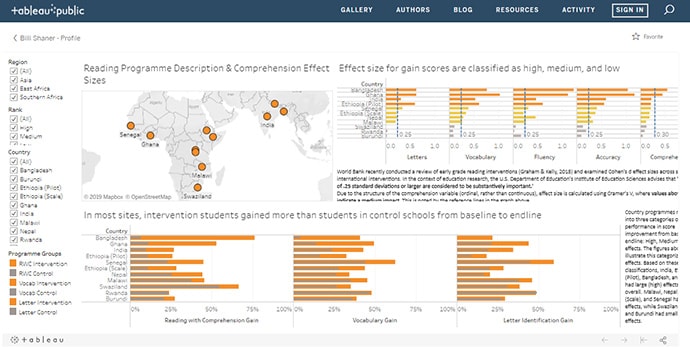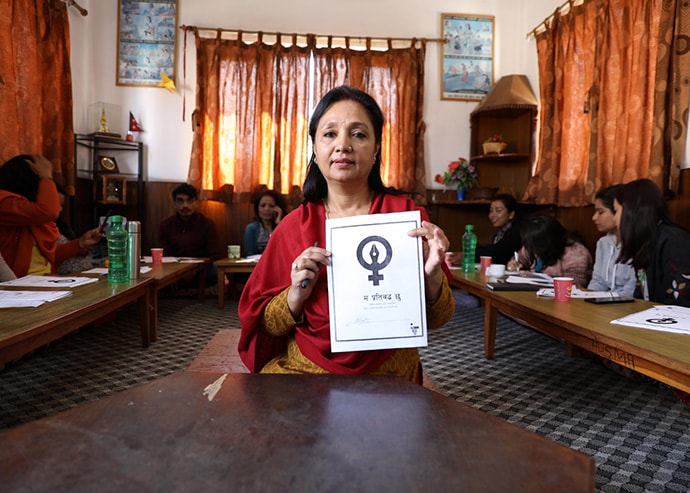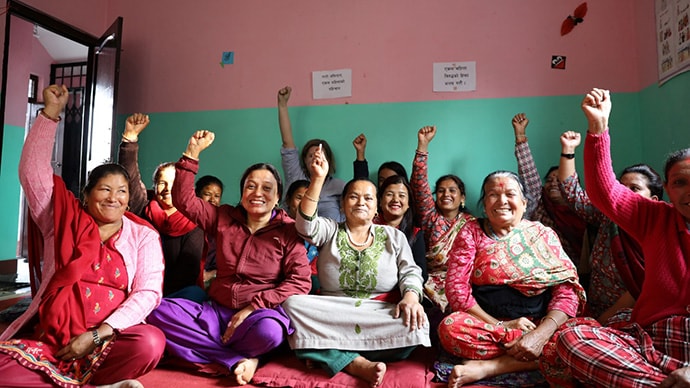August 2019 Newsletter
Posted on August 13, 2019.
Welcome to the August 2019 issue of the Global Washington newsletter.
IN THIS ISSUE
Letter from our Executive Director
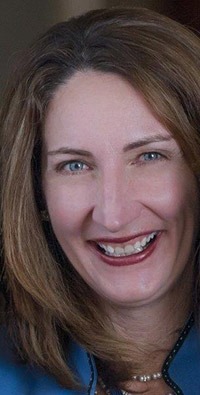
Within the UN Sustainable Development Goals (SDGs), we often think of education (SDG 4) as a standalone goal, but it is important to remember that other SDGs have education-related targets, as well. Some of these include reproductive health education, as well as information on sustainability, including a better understanding of climate change. These interlinkages are critical, as education is an important catalyst for achieving sustainable development as a whole.
Arguably, one of the most complex of the Sustainable Development Goal targets is SDG 4.7, which deals with how we learn to live together – peacefully, equitably, and sustainably.
With this target in mind, for the month of August we are highlighting efforts underway in developing countries to teach students about ethical leadership, and why this matters for building more sustainable, inclusive, and resilient societies globally. With climate change and increasing economic and social pressures around the world, many difficult challenges lie ahead that young people will need to be prepared to solve.
In this month’s newsletter, you can read more about this ambitious SDG target, and learn how Ashesi University is educating the next generation of ethical, entrepreneurial leaders in Africa. You’ll also read about how the founder of the Mona Foundation, inspired by her faith, invests in educating and empowering girls, and why she emphasizes the importance of service to the community.
At Goalmakers, our annual conference in Seattle, we will continue exploring the interlinkages between the Sustainable Development Goals and highlighting how our members’ work is helping accelerate progress toward them. Please note the NEW DATE for our 2019 conference – Friday, November 15.
I hope you can join us!

Kristen Dailey
Executive Director
Back to Top
Issue Brief
Educating Ethical Leaders for a Sustainable Future
By Joanne Lu
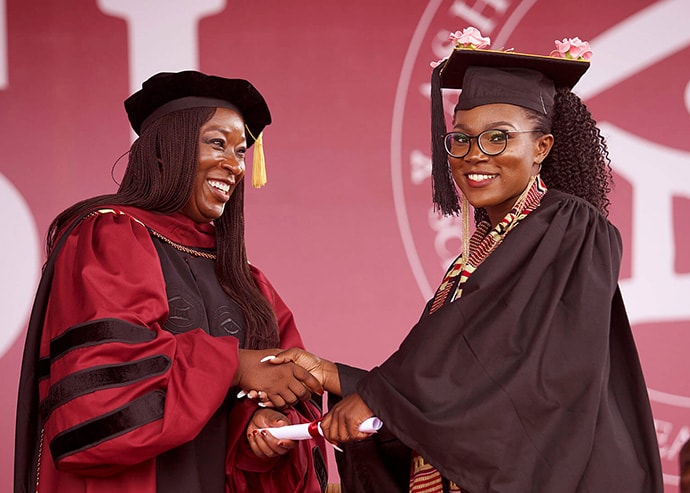
At Commencement, Ashesi Provost, Angela Owusu-Ansah, confers degrees on members of the Class of 2019. Photo provided by Ashesi University Foundation.
We all know how important an education is for getting a good job. But education should be much more than job training. It is a human right with the power to break cycles of poverty, achieve peace, change values and behaviors for the better, and move entire nations up the ladder of development.
But simply teaching literacy and arithmetic or even vocational skills isn’t enough to unleash the full potential of education. It takes quality education that equips every individual with the ethics and skills they need to tackle the daunting challenges ahead as effective leaders for a sustainable future. Especially in the face of added climate pressures, quality education for sustainable development is more important than ever.
The UN Children’s Fund (UNICEF) estimates that globally there are now 100 million more children in school than a decade ago. Under the UN’s Millennium Development Goals from 2010 to 2015, a concerted push to achieve universal primary education increased the primary school enrollment rate in developing countries to 91 percent, compared to 83 percent in 2000.
These improvements are critical to the world’s efforts to eliminate poverty. The United Nations Educational, Scientific and Cultural Organization (UNESCO) Institute for Statistics (UIS) estimates that the number of poor people in the world would be reduced by 55 percent if all adults completed secondary education. That’s 420 million people lifted out of poverty, because of the social mobility offered by a good education.
But quality education is also an important enabler for other development goals, including good health, reducing inequalities, tackling climate change and building peace. In Indonesia, for example, a study found that education levels were an especially strong predictor of who survived the aftermath of the 2004 tsunami.
However, the world fell short of achieving universal primary education by 2015, and now it looks like we’re not on track to achieve the latest goal for education either.
Sustainable Development Goal 4 aims to “ensure inclusive and equitable quality education and promote lifelong learning opportunities for all” by 2030. But progress has stalled, according to UIS, and an estimated 262 million children and youth between six and 17 years old are still not in school. That’s a staggering amount of kids who are being deprived of education because of injustices including war, famine, child labor and child marriage. They’re also at higher risk of exploitation because they’re not in school.
Much work has been done over the last couple decades to increase children’s access to education and encourage attendance – whether by building more classrooms, helping offset the cost of school books, fees and uniforms, or, in Brazil’s case, for example, even giving families a stipend in return for sending their children to school and getting immunizations.
Girls’ scholarships have also been very effective in not only providing access to girls whose families might otherwise prioritize boys, but also in keeping them out of child marriages. Educated mothers, too, are much more likely to make sure their own children go to school and complete their education. That’s why many organizations have made it a central focus to improve gender equality in education and promote a “gendered approach” – including safe, gender-separated and accessible toilets, reproductive and sexual rights education in curricula and the promotion of STEM (science, technology, engineering and math) subjects for women and girls. Although a gender gap persists (girls are 1.5 times more likely to be excluded from primary education than boys), today women (and men, too) are more educated than ever before.
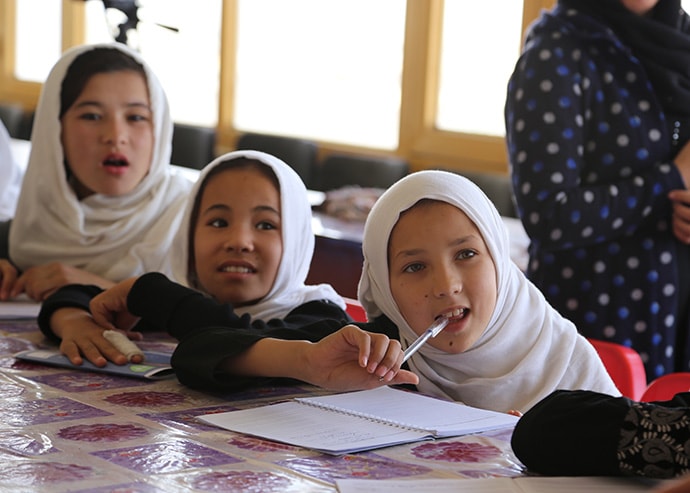
Students participate in Sahar’s Early Marriage Prevention Program in Mazar-i-Sharif, Afghanistan.
Photo credit: Freshta Ameri for Sahar.
With an increase of migration and displacement, children’s educations are also being disrupted, and the older a refugee gets, the less likely it is they’ll receive a quality education. According to the UN, less than a quarter of all refugees make it to secondary school, and a mere one percent makes it to university. Already overstretched refugee agencies are doing what they can to keep refugee and migrant kids in school, but much more still needs to be done.
The problem goes beyond just access to education, because even those who are attending school are not necessarily learning. An estimated 330 million children are in school but failing to learn, while only half of the adults in developing countries who have completed five years of school can even read a single sentence. UIS also projects that if current trends hold, four in 10 youth will have dropped out of secondary school by 2030.
The UN, World Bank and others call this problem the “global learning crisis.” A large part of the problem, they say, lies with a shortage of qualified teachers. In 2016, UNESCO warned that universal primary and secondary education would be impossible without 69 million new teachers, particularly in sub-Saharan Africa and South Asia. And data from the World Bank show that a substantial portion of existing teachers in Africa are functionally illiterate and innumerate. While almost 90 percent of teachers in Kenya could do a simple division problem, less than 6 in 10 teachers in Nigeria could do the same.
Solving this qualified teacher deficit requires investing heavily in teachers – in their wages, training, supplies and support system. And technology advances are making it easier. Remote teacher training platforms are now able to reach teachers in poor, rural areas that have relied for too long on rote learning and dictation.
New investments in teachers also creates an opportunity to expand students’ learning beyond just the basic subjects. We need to “ensure that all learners acquire the knowledge and skills needed to promote sustainable development, including, among others, through education for sustainable development and sustainable lifestyles, human rights, gender equality, promotion of a culture of peace and non-violence, global citizenship and appreciation of cultural diversity and of culture’s contribution to sustainable development.” This is Target 7 under SDG 4.
As conflicts have become deadlier and more prolonged, as inequalities undermine and stall progress, and as climate change threatens the very existence of species and communities, we must prepare students today to become effective leaders and innovators of tomorrow. It is critical that they are empowered at every level – from primary school to university – to “change the way they think and work towards a sustainable future,” as UNESCO puts it.
Ashesi University in Ghana, for example, recognizes that university students will most likely be the future leaders of the African continent. So, in addition to equipping them with technical majors based on market needs, including computer science, engineering and business administration, they also aim to “cultivate within students the critical thinking skills, the concern for others and the courage it will take to transform the continent.” This understanding is built into their curriculum, into the teaching style of their professors, and into the culture of the school.
Even if we miss certain targets within the Sustainable Development Goals by 2030, we can still lay the groundwork for achieving them down the road by making sure everyone has access to quality education that transforms the way we interact with our planet and each other for the better. This is the full potential of education.
* * *
The following Global Washington members are working to improve access to quality education around the world:
Ashesi University Foundation
Ashesi University aims to propel an African renaissance by educating a new generation of ethical, entrepreneurial leaders. Located in Ghana, this private, non-profit, liberal arts university combines a rigorous liberal arts core with degree programs in Computer Science, Business Administration, Management Information Systems, and Engineering. Ashesi invests in students from diverse economic, ethnic, religious, and national groups by building leadership development, character, and community service into a four-year curriculum. Upon completion, Ashesi graduates are emboldened to tackle persistent problems in their communities, create jobs, and lead with purpose. The Seattle-based Ashesi University Foundation exists to fundraise for Ashesi University and raise international awareness about the school’s impact. ashesi.org
BuildOn
For two decades buildOn has mobilized rural communities in some of the economically poorest countries on the planet. The organization builds schools with villages that lack adequate classrooms – where students learn in huts, are taught under trees, or walk miles to a neighboring villages. Or don’t go to school at all. To date, buildOn has built 1,323 schools internationally. buildon.org/what-we-do/global
Committee for Children
Committee for Children is a non-profit on a mission to ensure children everywhere can thrive emotionally, socially, and academically. Best known for its innovative social-emotional learning (SEL) curricula that blend research and rigor with intuitive program design, Committee for Children empowers children and their adults with skills that help them realize their goals in the classroom and throughout their lives. Since 1979, the organization has been connecting experts in the field to share experiences and advance the cause of educating the whole child. A force in advocacy, Committee for Children is helping pass policies and legislation that place importance on creating safe and supportive learning environments. Today its programs reach more than 15 million children in over 70 countries worldwide—by lifting up children today, Committee for Children is helping them create a safe and positive society for the future. cfchildren.org
InformEd
InformEd International works to create sustainable solutions to the toughest education challenges through data-driven consulting services and market-based programs. The organization supports non-profit organizations and businesses operating in the international education sector to strengthen their social impact through evaluations, operational research, strategy design, and data systems that enable achievement of organizational and project objectives. Furthermore, InformEd’s program designs aim to change the world by thinking outside-the-box, creating business opportunities that improve social wellbeing. Currently InformEd is using a Developmental Evaluation approach to drive the creation of a School Leadership and Management program with Save the Children. InformEd is also building monitoring and evaluation systems for organizations like World Vision and Amplio, bringing data to life through interactive data visualizations. The team is excited about upcoming opportunities to improve numeracy outcomes and strengthen the global book supply chain. informedinternational.org.
Mercy Corps
Mercy Corps helps young people and adults access education in the face of war, poverty or other crises. Last year the organization supported more than 237,000 people access quality education and helped reconstruct or build more than 320 schools around the world. For example, Mercy Corps provides education and skills building training to children and teens living in conflict zones in Colombia. Through after school programs, investments in teacher training and increased involvement of parents in students’ academic life, Mercy Corps’ program contributed to an over 30 percent improvement in mathematics and language among student participants. mercycorps.org
Mission Africa
Mission Africa believes that education is the key to ending generational poverty and that investment in education can have a profound impact on communities. Many African countries do not offer free education and Mission Africa is dedicated to ensuring that all children regardless of their income level have access to quality education. In the past ten years, Mission Africa’s academic scholarship program has awarded 795 scholarships and has allowed more than 300 students in rural villages in Nigeria, Tanzania, Kenya, Sierra Leone, Togo, Rwanda and Uganda to graduate high school and continue on to college or vocational training. Mission Africa has also shipped ten 40-foot containers filled with books and school supplies to children and families in Nigeria, Kenya and Tanzania. missionafrica.us
Mona Foundation
Since its founding in 1999, Mona Foundation has had a simple but compelling goal — to support grassroots educational initiatives that build stronger and more sustainable communities and ultimately alleviate poverty. Mona partners with organizations that work to reduce the barriers to education, improve quality of learning and cultivate agency of the individual. The foundation’s programs use an integrated approach to develop academic skills, and creative and moral capabilities, to transform young people into agents of change in service to their families and communities. Mona Foundation has awarded more than $12 million to 38 initiatives in 18 countries, providing access to quality education and training for more than 258,000 students, teachers and parents annually. monafoundation.org
The Northwest School
The Northwest School in Seattle is an independent 6-12 school that strives to develop active informed citizens who understand the complex interconnections that characterize our most urgent challenges, both locally and globally. Through intentional curriculum and programs, students develop social justice awareness, environmental stewardship, and global perspective, and come to understand the critical intersection between these three. The Humanities curriculum emphasizes literature by developing world writers, people of color, and women. Seniors engage in college-style seminars examining literature, history, and world politics through equity and social justice lenses. The Environment Program requires students to clean the buildings and school grounds, as well as recycle and compost, while the student-led Environmental Interest Group maintains the school’s urban farm/garden. Domestic students learn alongside 50-80 international students in the boarding program. Students also participate in three annual trips abroad to China, Taiwan, France, Ethiopia, Spain, and El Salvador, and immerse in six-week study-abroad opportunities in France, Spain, China, and Taiwan. northwestschool.org
NPH USA
NPH USA supports Nuestros Pequeños Hermanos (Spanish for “Our Little Brothers and Sisters”) which is raising more than 3,400 orphaned, abandoned and disadvantaged boys and girls in Bolivia, the Dominican Republic, El Salvador, Guatemala, Haiti, Honduras, Mexico, Nicaragua and Peru. NPH believes that a quality education is the key to a better life. Many children arrive at NPH with little or no formal schooling. Each child is given a strong foundation of basic academic and interpersonal skills and provided with an extensive variety of educational opportunities. Nearly all of NPH homes feature on-site schools from Montessori preschool through middle or high school, as well as vocational trade certification courses. In 2015, NPH supported 369 students in university – the most in the organization’s history. An additional 2,100 children who live in low-income areas outside the homes receive scholarships to attend NPH schools. nphusa.org
Rwanda Girls Initiative
Rwanda Girls Initiative’s mission is to educate and empower girls in Rwanda to reach their highest potential. The organization strives to cultivate inspired leaders with a love of learning and a sense of economic empowerment to strengthen their communities and foster Rwanda’s growth. The Gashora Girls Academy of Science and Technology (GGAST) was opened in 2011 as an innovative and socio-economically diverse model upper-secondary school, designed to provide a “whole girl” education. GGAST provides a rigorous college prep academic program, combined with leadership training and extra-curricular activities that fill girls with confidence that they can pursue their dreams of university education and fulfilling and impactful vocations. rwandagirlsinitiative.org
Sahar
Sahar’s mission is to create educational opportunities in Afghanistan that empower and inspire children and their families to build peaceful, thriving communities. Sahar achieves its mission by partnering with the Afghan Ministry of Education and Afghan-based organizations to build schools and design educational programs that address the key barriers to accessing and completing education for girls. Sahar’s programs include a unique Early Marriage Prevention program, designed to encourage girls to delay marriage and stay in school; teacher training courses that provide jobs to young women, while simultaneously decreasing the lack of female teachers that keep many girls out of school; coding classes; and much more. Currently, Sahar is raising funds to build the first public boarding school for girls in Afghanistan, providing a safe option for rural girls to receive their education. sahareducation.org.
Schools for Salone
Schools for Salone is a non-profit that revitalizes Sierra Leonean communities, empowers children and improves socioeconomic conditions for families, communities and future generations. The organization improves access to and quality of education, and has built 18 schools and three libraries since 2005. Schools for Salone also trains teachers at intensive summer institutes. With a proven track record of working with Sierra Leoneans as they rebuild after a ten-year civil war, the organization builds new schools within three months after funds are raised. Through opportunities that only an education can provide, Schools for Salone strives to break the cycle of poverty, one school at a time. schoolsforsalone.org
Spreeha
Spreeha empowers underprivileged people by providing healthcare, education, and skills training. Spreeha’s work in the Rohingya refugee camps in Bangladesh builds on its core values of empathy, creativity, lean methodology, continuous learning, and partnership. The objective is to create longer term positive changes like healthcare and education for women and children. In most cases, those being served are pregnant and rape victims or children who have been orphaned. Spreeha’s early childhood development centers aim to create a safe and supportive learning environment for the refugee children with pre-school education. Spreeha strives to create lasting impacts on the lives of those who are in the most difficult of situations. spreeha.org
The Spring Development Initiative
The Spring Development Initiative (TSDI) is a Redmond-based global non-profit that supports aspiring African leaders working towards positive social change. TSDI provides training, collaboration and investment to self-employed and early career professionals, with the aim of fostering new and innovative business and non-profit ideas and models that will lead to sustainable development. As part of its work, TSDI recruits experienced mentors and encourages a positive work ethic for future careers in policy making, business, governance, etc. TSDI is currently working with SI4DEV, a local organization in Nigeria, to provide two programs aimed at establishing quality education, entrepreneurship, sustainable lifestyles, gender equality, peace and cultural diversity among local communities. The Life Skills project reaches students 10 to 19 years old, and encourages self-reliance, resilience and employability. The Street Business School project trains youth and women living in urban-poor communities how to increase their income by building and scaling sustainable businesses. sid-initiative.org
Back to Top
Partnership Highlights
Data Visualization Prompts Deeper Questions about the Effectiveness of Early Grade Education Intervention
By Lisa Zook & Cameron Ryall
Data visualizations by Billi Shaner
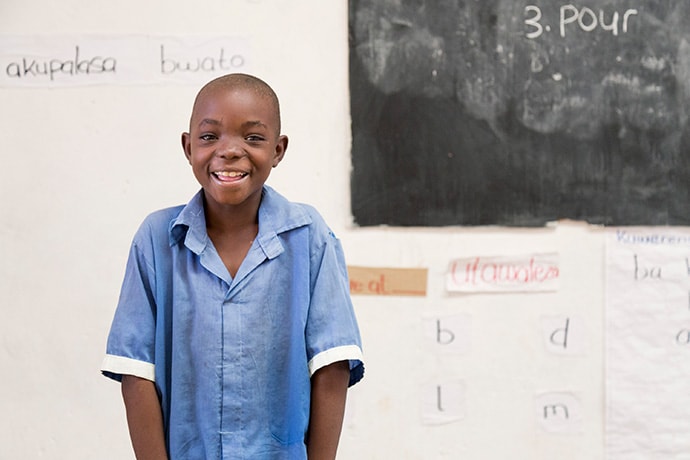
Mphatso, 8, a Grade 3 student in the World Vision Malawi Literacy Boost program.
Photo credit: World Vision Malawi
More than half of children globally do not meet minimum proficiency standards in reading and mathematics. InformEd International and World Vision are re-examining data collected in their work to improve early grade reading outcomes using Tableau’s data visualization software. This has enabled greater insights into the early grade education programming’s effectiveness, as well as demonstrated where there is room for improvement.
From 2012 to 2017, World Vision International, in partnership with Save the Children, implemented an early grade reading program called “Literacy Boost” in ten countries throughout Africa and South Asia. The goal was to equip schools, parents, and communities to support children’s literacy from kindergarten through third grade. As part of each country’s program, World Vision coordinated randomized-controlled trials to determine the program’s impact. This provided a unique opportunity to examine the impact across a variety of contexts.
After 2017, World Vision had a series of rich datasets from each project site and a set of country-specific reports. At a global level, however, it was challenging to make sense of the disparate reports. Students in the intervention schools generally outperformed students in comparison schools, but questions remained: At what point is a program considered a success? What led to different results in different countries? Should certain programs be taken to scale, and if so, when?
In order to answer these questions, InformEd analyzed the reading outcomes from each country’s dataset, and compared them against student benchmarking standards from the World Bank.
As part of the reporting process, InformEd used Tableau data visualization software to create a dashboard and an accompanying story summarizing the results. The story provides an overview of the conclusions drawn from the research, while the dashboard allows for sub-group filtering of the results (by country, region, and by effect size rank). Both resources led to greater engagement with findings than a traditional report and sparked important discussions among program staff. (Explore the dashboard and story here).
Eight of the eleven implementation sites exhibited effect sizes that surpassed the World Bank’s benchmark for a significant gain in educational outcomes. In the four countries with particularly strong effect (Bangladesh, Ethiopia, Ghana, and India), students received the equivalent of an additional year of learning as a result of the Literacy Boost program. The other three sites saw significant differences in children’s reading performance between intervention and control, but only small effect sizes.
Most importantly, in viewing the data in this way, InformEd found that a project’s performance was falling into one of three categories: high, medium, or low. The performance classification held across learning outcomes, showing that Literacy Boost doesn’t only impact struggling students or strong students, but rather has a positive impact on children along the entire path to becoming a reader.

Students in reading camps make reading materials in World Vision India’s Literacy Boost program.
Photo credit: Max Greenstein / World Vision
Identifying these trends sparked new questions for those working on the project. Firstly, how did program implementation differ across the three categories of performance? To answer this question, InformEd has worked with World Vision to develop a suite of electronic data collection tools to monitor program implementation and uptake. Data from the monitoring activities is then uploaded and visualized in real-time, empowering program staff to identify communities or technical areas needing additional support. (View the monitoring system here).
Furthermore, the teams want to investigate if certain variables enable the program to achieve greater results. For those countries that observed large effect sizes, what makes them different from those that didn’t meet the World Bank threshold? Were children at a different starting point? Or were some schools and teachers more active in program activities or more likely to adopt behaviour change? If so, why? If there are certain characteristics identified, perhaps the Literacy Boost approach needs to be adapted for certain challenges, contexts, or settings. These findings can also contribute to global dialogue on effective practices to support achievement of SDG 4.
Deeper analyses of existing data are leading to important advancements in our discussions about and our knowledge of how best to address the learning crisis. We’re hopeful that we are getting closer to knowing what works where so that we better address the unique needs of each child and, ultimately, ensure that all children are receiving quality education.
Back to Top
Organization Profile
Ashesi University Foundation: Ashesi University is Shaping Africa’s Future Leaders
By Joanne Lu
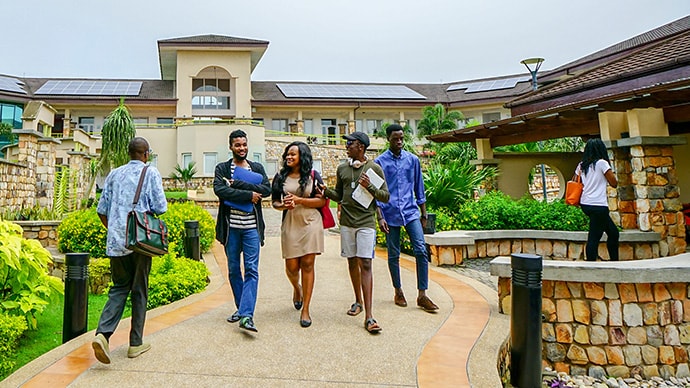
Students walk across the Ashesi University campus. Photo provided by Ashesi University Foundation.
“Whatever you can do or dream you can, begin it. Boldness has genius, power and magic in it. Begin it now.”
These words from German philosopher Johann Wolfgang von Goethe are engraved on the glass doors of the entrance to Ashesi University in Accra, Ghana. When the university’s founder, Patrick Awuah, quit Microsoft to pursue his vision of educating Africa’s future ethical and entrepreneurial leaders, Goethe’s exhortation offered him the reassurance he needed. It also inspired the name of his school: Ashesi means “beginning” in Asante.
For Awuah, the beginning of Ashesi’s story goes back to his own college education at Swarthmore. Even as an engineering student, he was studying subjects like political science, history, and economics, and gaining an understanding of the context in which innovation and industrialization happens. The liberal arts approach was different from any educational model he’d seen at home in Ghana.
The longer Awuah spent in the States, the more determined he was to stay. He enjoyed living here, loved his work, and was frustrated with Ghana’s lackluster development. But things shifted with the birth of his first child. Suddenly, Awuah realized that the future of Africa was important for his children and his grandchildren, and to honor their ancestry and legacy, he had to be a part of helping Ghana thrive.
Awuah’s initial instinct was to start a software company – after all, he worked for Microsoft. But the more he researched and talked with others, the more he realized that a lack of visionary leadership is what continued to hold back Ghana from thriving.
That’s when Awuah turned his focus to starting a university. Although less than 10 percent of Ghanaian youth at the time were attending university, Awuah knew that the leadership of the future would likely come from that small base. Therefore, he wanted to give them the tools they needed to lead differently – to lead ethically and effectively.
“If we can help our students discover who they are and understand where they stand in society and the responsibility that they have to their society, we will have achieved a great deal,” says Awuah.
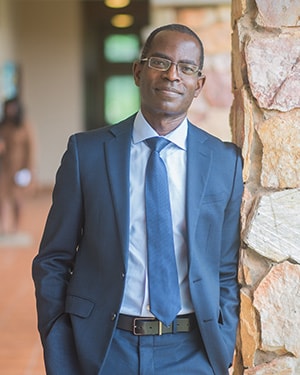
Patrick Awuah, founder of Ashesi University. Photo provided by Ashesi University Foundation.
Awuah launched Ashesi University in 2002 with 30 students. Today, there are 1,013 students from more than 20 countries, and by 2020, they expect to have 1,200 students. Currently, 17 percent of the student body is international students, and eventually, Ashesi aims to make that 30 percent. But no more than 10 percent will ever be from outside Africa, because the goal is to invest in African students as the continent’s future leaders.
Currently, Ashesi offers four majors that were designed in response to what’s needed in the workforce: management information systems, computer science, business, and engineering. But, like Awuah’s own Swarthmore education, these technical majors are based on a liberal arts curriculum that equips students to navigate the context in which they will innovate and solve problems. It’s not just about offering a well-rounded curriculum. Ashesi’s curriculum is designed to complement technical skills with a holistic understanding of African history, society and the world at large in order to instill in students critical and entrepreneurial thinking.
By entrepreneurial thinking, Ashesi doesn’t just mean starting and running businesses (although, it does encourage students to do that, too). Ashesi defines entrepreneurial thinking as identifying and solving problems – something that’s not commonly taught in African schools, where students are often trained to spit back one particular answer and adhere to one way of doing things. Perhaps that’s why leaders on the continent have for so long been able to perpetuate power imbalances and poverty, despite local and international investments, natural resources and economic resources, says Megan MacDonald, Director of Strategic Partnerships at Ashesi University Foundation.
MacDonald also notes that in a context of poverty, human instinct is to take for oneself when one gains access to resources. But especially with Africa’s booming population growth and the added challenges of post-colonialism, the continent needs leaders who are looking at the bigger picture and who are capable of making choices for the wellbeing of everyone.
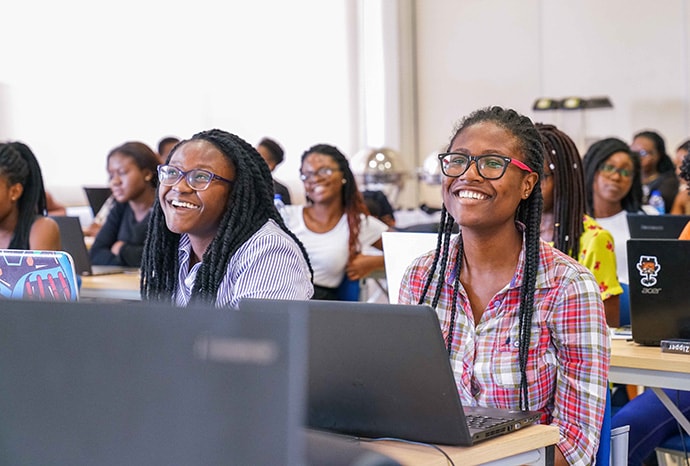
Students in class at Ashesi University. Photo provided by Ashesi University Foundation.
It is not enough just to tell students they should adhere to a certain set of values. They need to have the tools to put those values into practice. That’s why Ashesi’s approach gives students the tools and the practice they need to make different choices, to show by example that it is possible to lead ethically and dismantle systems of corruption.
And they’re doing just that. Hannan Yaro Boforo from the class of 2010 developed an AI-powered biometric coding system (thumbprint technology) that was used in Ghana’s 2012 presidential elections to help increase voter turnout and fight voter fraud. Now, he and his team are helping to implement similar technology in other African countries and other sectors, including healthcare and social intervention programs.
Kpetermeni Siakor from the class of 2015 was still a student at Ashesi when the Ebola outbreak devastated his home country of Liberia. From Ashesi’s campus in Ghana, he reached out to a non-profit in Liberia and ended up partnering with the government to create deployment tools for health workers all over the country, tracking their movements and the distribution of support. So, even while he was a student, he found a way to impact an entire country’s response to one of the deadliest outbreaks in history.
That’s why MacDonald says Ashesi has become a symbol of possibility for Africa, and why Ghanaians at home and abroad have called Ashesi “the pride of Ghana.” Beyond expanding their own scope in the future – with graduate degrees and more research capacities being considered – Ashesi hopes to continue to inspire new and existing institutions. Already, MacDonald says that some local universities in Ghana have begun to adopt a more liberal arts approach, while a new university in francophone Niger – Africa Development University – cites Ashesi as a founding model. Ashesi also runs an “Education Collaborative,” which brings together universities from across the continent – last year, it was 24 – to share best practices, troubleshoot and create an active network of institutions, committed to elevating higher education in Africa.
“In international development, there are so many external solutions to local problems,” says MacDonald. “But the whole ethos of Ashesi is that in order to solve Africa’s problems, we need to equip African leaders. I think that is really powerful, and the best thing that those of us from the international development community can do is to invest and support that leadership.”
Back to Top
Goalmaker
Mahnaz Javid: President & CEO, Mona Foundation
By Amber Cortes
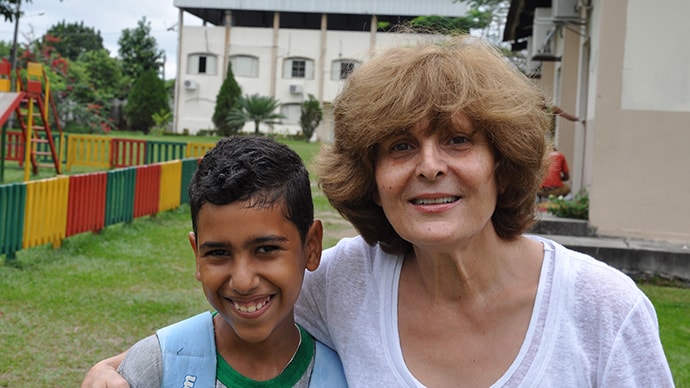
Mahnaz Javid poses with a student at The Association for Cohesive Development of the Amazon (ADCAM), located in Manaus, the capital city of the State of Amazonas, Brazil. Since 2006, Mona Foundation has supported the project with scholarships and funds for capital improvement. Photo provided by Mahnaz Javid.
“Mahnaz, do not forget”
An unforgettable cab ride at a young age became a defining moment in the life of Mahnaz Javid. Growing up in Tehran, the capitol of Iran, Javid had what she described as a comfortable childhood in a “regular middle-class family.”
“When I was 12 years old, I was restless! So, my mother decided, as a way of managing my energy, to take me for a cab ride,” Javid explains. “So, we left the nice tree-lined streets of our block towards the southern part of the city, where I knew, even at that time, that this was where the poor people lived. It’s where the slums were.”
Javid remembers the rain that day, how it poured down and began washing away people’s makeshift homes right in front of her eyes.
“So, we went around for about half an hour and returned home. And I was just absolutely stunned, you know, just stunned by what I saw. And before we got out of the cab, my mother looked at me and said, ‘Mahnaz, do not forget.’”
She didn’t. “I think it just imprinted in my subconscious from then on, all the way to when I started Mona.”
“Without a moral compass, no development can happen”
Javid started the Mona Foundation in 1999 in order to provide education to all children, to empower girls, in particular, and enable them to transform their own communities.
A set of universal principles informs much of the work she does in the Mona Foundation. These principles are Baha’i inspired but equally shared by people of all traditions. For example, the principles of universal education and equality helped guide their model of philanthropy to be community-first.
“We do not import our ideas from here to there,” Javid says. “We find grassroots, local organizations to support, and empower them to lead their own development. Why? Because we believe that they are equally capable of developing their own communities.”
The Mona Foundation believes that access to education, along with gender equity, are key to alleviating global poverty (and The World Bank agrees). Though promoting education for all is important, since the global gender gap in education is so severe, the Mona Foundation focuses much of its efforts on educating girls and women.
“We know that women are at the core of development,” Javid says. “When you educate a woman, you positively impact health, you reduce hunger, you benefit families, you increase productivity, and you promote a sustainable environment.”
For Javid, the foundation to any education lives within a less material, more value-based and spiritual kind of development. She is quick to point out that what she means by “spiritual” is not necessarily religious. The basic questions about the nature of human existence—Why are here? How do we find meaning in our lives?—all form a basis for inquiry that transcends an individual’s religious beliefs and can shape a person’s ethical framework—a moral compass to guide one through life.
“Without a moral compass, no development can happen,” Javid says. “Without a moral compass, you only look at your own self-interest. You do not look after the interest of your community, of your family, of your extended family, of your nation.”
At the Mona Foundation, laying the groundwork for this moral compass starts early, by supporting programs that focus on creating sustainable development through teaching youth global citizenship. For example, supporting scholarships at the Badi School in Panama, which emphasizes moral leadership training and developing values such as integrity, trustworthiness, patience, teamwork, respect for others, and community service. There are also Global Citizenship Clubs, formed by students themselves, to help inform the worldview of the children and their place in it, and training them to provide service to the community.
For Javid, a holistic, well-rounded education means more than just teaching business and finance skills. The Mona Foundation’s philosophy of education is multi-faceted—it includes supporting fine arts, music, and creative-thinking programs in places like the Zunuzi school in Haiti and the Barli Institute in India.
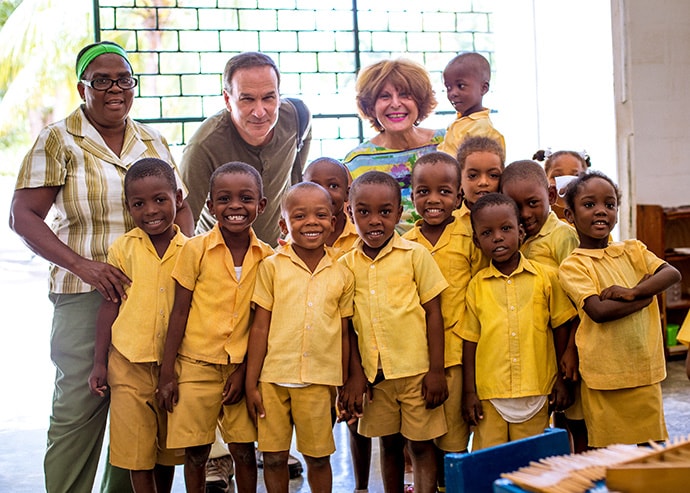
Mahnaz Javid poses with students and faculty of the Zunuzi school in Haiti.
Photo provided by Mahnaz Javid.
These values align with one aspect of the United Nations’ Sustainable Development Goal for education (SDG 4, Target 4.7), which seeks to ensure learners move into the future with “knowledge of human rights, gender equality…global citizenship and appreciation of cultural diversity and of culture’s contribution to sustainable development”
Development, Javid says, should never be tied solely to just economics.
“So, if you are a “developed” nation – if you’re not hungry, if you have access to health care, clean water, electricity – these are all required and necessary indicators of development. But if men and women are not equal in that nation, what sort of development is that? Yes, you can build schools. But if girls cannot go to school, what do you have?”
“We can only make a difference together”
As Javid and others at the Mona Foundation celebrate the first twenty years of their existence, their impact continues to be wide reaching. In 2018, the programs they supported directly served over 400,000 students, parents, teachers, and schools. Over one million people have benefited from extension programs that the schools offer, like health clinics and empowerment programs.
While Javid says that alleviating global poverty through education is the ultimate goal, individuals transforming their own communities, one at a time, is what causes the real ripple effect of sustained change.
“If you look at the projects that we have supported over the years, they have all resulted in community transformation. So, it isn’t about just educating girls to us, say at Barli Institute in India. It is about educating those girls to go and transform the hearts and minds of their own village around the question of equality.”
Javid sees the Mona Foundation continuing to thrive in the future—but not without the help of the forward-thinking schools and organizations in their network.
“If Mona worked from now until the end of the world, we would not be able to make a dent in the way that things are all by ourselves,” she says. “I think that we can only make a difference together, in partnership with our adopted local organizations who are doing the actual work of development in the field, and by sharing our learnings with like-minded organizations who are supporting these and other similar initiatives. Together, we are confident that we can address the root causes of poverty through education and gender equality and can create a world where no child ever goes to bed hungry, is lost to preventable diseases, or is deprived of the gift of education.
Back to Top
Welcome New Members
Please welcome our newest Global Washington members. Take a moment to familiarize yourself with their work and consider opportunities for support and collaboration!
RISE BEYOND THE REEF
Rise Beyond the Reef bridges the divide between rural remote indigenous Fijian communities and the outside world, promoting women as leaders of their communities on the frontlines of climate justice. risebeyondthereef.org
Back to Top
Member Events
August 13-14: Amazon // Imagine Conference
August 29: Seattle International Foundation // Crisis & Migration: A Conversation with Central American Independent Media
October 24: Sahar // Fall Fundraiser
November 21: BuildOn // Gala
Back to Top
Career Center
Communications Assistant, Amplio
Manager of Student Programs, FIUTS
Executive Assistant, Essential Medicines, PATH
Check out the GlobalWA Job Board for the latest openings.
Back to Top
GlobalWA Events
August 22: Networking Happy Hour with GlobalWA, WGHA, & World Affairs Council
September 5: The Fast Funding Fundamentals
September 13 A Conversation with Feminist Rukhshanda Naz from Pakistan
New Date November 15: GlobalWA Goalmakers Conference
Back to Top
Intersectionality for Inclusivity: Recognizing the Human Rights of Every Human
Posted on August 5, 2019.
By Anna Pickett and Josué Torres
Introduction
In the context of global development, disability is too often ignored or rendered invisible. Organizations that work to promote equity often times don’t support disabled populations because disability is not one of their focus areas, or because they have other priorities. But the truth of the matter is, if an organization works on human rights without including people with disabilities, they are only really promoting the rights of some humans.
With this work, applying an intersectional approach allows for a deeper and more nuanced understanding of how social identities and conditions interact within a society. As a result, we gain a broader picture of human diversity. In discussing inclusion in global development and improving the standards for living a life of dignity, we must understand the concept of intersectionality and have the awareness that disability is a human condition that is present in a significant percentage of the global population. According to the World Bank, one billion people, or 15% of the world’s population, experience some form of disability.
Continue Reading
Event Recap: Disability Inclusive Development Initiative Workshop
Posted on August 5, 2019.
By Kara Eagens
In June, Global Washington hosted members of the Disability Inclusive Development Initiative (DIDI) to introduce best practices for disability inclusion in international development.
DIDI is a multidisciplinary research and advocacy project at the International Policy Institute of the University of Washington’s Henry M. Jackson School of International Studies. Comprised of graduate and undergraduate students, DIDI works to support the inclusion of persons with disabilities in development.
Stephen Meyers, a professor of disability studies and international studies at the University of Washington, opened the event with remarks on the realities of disability inclusion within the international development sphere.
Continue Reading
EVENT RECAP: Roundtable with Michelle Nunn, CARE USA President and CEO
Ending Violence Against Women
By Peachie Ann Aquino
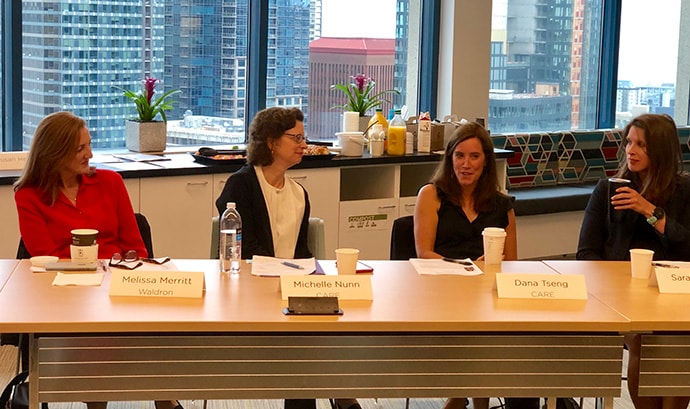
CARE USA President and CEO, Michelle Nunn (second from left) is joined by CARE colleagues at Global Washington for a roundtable discussion on ending violence against women.
(Photo: Peachie Ann Aquino for GlobalWA).
“Achieving real equality for women and eradicating gender-based violence can transform the world in many ways” stressed Michelle Nunn, President and CEO of CARE USA. “The highest and most powerful good that we can do is to invest in local women’s grassroots movements who are creating social and societal change”
Continue Reading
July 2019 Newsletter
Welcome to the July 2019 issue of the Global Washington newsletter.
IN THIS ISSUE
Letter from our Executive Director

We all want a better life for our families and for ourselves. I’d go so far as to say the impulse to improve our lot in life is pretty much universal. When people can no longer bear the conditions in which they live, when they can no longer count on being able to take care of the ones they love, they are willing to do whatever it takes to change those circumstances. Human traffickers look for desperate people like these. Promising them work and a better life, they lure them into some of the most horrific working conditions imaginable. According to the UN, the majority of detected trafficking victims globally are women and girls, most of whom are trafficked for sexual exploitation.
Our newsletter this month explores the terrifying reality of human trafficking in developing countries and some of the ways that organizations and individuals are fighting back. Our Goalmaker this month, Veronica Fynn Bruey, an affiliated faculty member at Seattle University School of Law, escaped the civil war in Liberia to become an award-winning scholar in law, public health, science and psychology, as well as an advocate for displaced and trafficked persons globally. Our featured member organization, Every Woman Treaty, is campaigning to establish a global treaty to end violence against women and girls.
Also, I’m excited to announce that registration for our annual conference in Seattle on December 5th is now open. The conference sold out last year, so if you know you plan to be there, take advantage of Early Bird pricing and purchase your tickets today.

Kristen Dailey
Executive Director
Back to Top
Issue Brief
What Will It Take to End Modern Slavery?
By Joanne Lu

A former fishing boat slave profiled in the new film, Ghost Fleet.
Photo courtesy Vulcan Productions.
We often think of slavery as a scourge of the past, something that developed countries, at least, abolished centuries ago. But devastatingly, slavery continues to thrive around the world, in both rich and poor countries – so much so that it is addressed in three of the UN’s Sustainable Development Goals (SDGs) for 2030. Today, we call it human trafficking.
Although the term often evokes the idea of victims being smuggled across borders, human trafficking is much more than that. It is the exploitation of people – usually girls and women – through force, fraud or coercion for labor, sex, marriage, organ removal, illegal adoption, begging or other purposes.
In January, the UN’s Office of Drugs and Crime (UNODC) said that the number of trafficking victims being reported by countries is increasing. However, it’s difficult for the agency to say if that trend reflects an actual increase in victims or if countries are just doing a better job at detecting and reporting them. Either way, we are far from a complete and accurate picture of the global scale of trafficking, but what we do know is bleak.
The latest UN estimate says that at any given time in 2016, there were 40.3 million victims of human trafficking around the world. In other words, more people than are in the entire state of California are being subjected to modern slavery, including nearly 25 million people in forced labor and 15.4 million in forced marriages.
The UNODC report says that the vast majority of detected trafficking victims – 72 percent – are women and girls, most of whom are being trafficked for sexual exploitation. However, 35 percent of victims who are trafficked for forced labor are also female. That’s why SDG 5, which aims to “achieve gender equality and empower all women and girls,” includes as Target 2 to “eliminate all forms of violence against all women and girls in the public and private spheres, including trafficking and sexual and other types of exploitation.”
Although trafficking is a global problem, the predominant forms of exploitation and profiles of victims vary by region. In East Asia and the Pacific, both women and girls are primary targets for sexual exploitation. In North America, South America, Western and Southern Europe as well as Central and Southeastern Europe, adult women face the highest risk of sexual exploitation, while in Central America, it’s girls.
Women are also primarily targeted for sexual exploitation in Eastern Europe and Central Asia, but there, men are prime targets for forced labor, as well. In the Middle East, East Africa and Southern Africa, men and women are both targeted for forced labor. But in West Africa, children are the main victims of trafficking for forced labor.
Men, women, girls and boys are all at high risk of being trafficked in South Asia. For men, it’s mostly for forced labor, while for women and children it’s for both labor and sexual exploitation. Similarly, in North Africa, adults and children of both genders are targeted by traffickers, but there, it’s primarily for begging, organ removal and other forms of exploitation.
According to the UNODC, most trafficking victims are detected in their home country. However, the highest number of victims detected outside their home region are from East Asia and sub-Saharan Africa. On the receiving end, wealthy countries – especially in Western and Southern Europe and the Middle East – have the largest shares of trafficking victims from other regions.
So, what’s driving this global epidemic? In many cases, traffickers capitalize on potential victims’ desire to migrate for better conditions. Increasingly, that desire is driven by conflicts, which have destabilized governments, threatened the physical safety of civilians, eliminated economic opportunities and pushed many families into poverty and hunger. Weak rule of law and depleted resources create ideal environments in which traffickers can prey on desperate people.
But trafficking is also a lucrative operation. In 2014, the International Labour Organization (ILO) reported that forced labor generates $150 billion in illegal profits every year. Two-thirds of that is from commercial sexual exploitation, while the rest is from other forms of economic exploitation. Of those, construction, manufacturing, mining and utilities industries profited the most ($34 billion), followed by agriculture, forestry and fishing ($9 billion) and domestic labor ($8 billion).
Vulcan Productions – a film company founded by Microsoft’s co-founder Paul G. Allen and his sister, Jody Allen – recently brought to audiences the appalling realities of the modern slave industry. Their documentary, “Ghost Fleet,” follows Thai activist, Patima Tungpuchayakul, and her husband, Sompong Srakaew, as they risk their lives to rescue enslaved fishermen in Indonesia. Many were kidnapped from Thailand and Myanmar to “feed the world’s insatiable appetite for seafood,” including fish found in U.S. grocery stores.
Although the fishing and agriculture sectors are certainly responsible for a large share of slavery, the ILO noted in a 2017 report that, apart from sexual exploitation, domestic labor actually accounts for the largest percent (24 percent) of identified forced labor cases in the private economy. That’s because most countries do not protect domestic workers under their labor laws. Many coercive practices also occur in construction, which accounts for 18 percent of identified forced labor exploitation cases.
Perhaps the sector that has received the most attention for forced labor practices is manufacturing, where 15 percent of identified cases occur. In particular, small garment and footwear factories in South Asia have come under public scrutiny, as have electronics brands. But forced labor is also prevalent in many other forms of manufacturing that haven’t received as much attention, such as medical garment factories in Asia that rely on migrant workers or technology companies that use minerals in their products mined from conflict zones.
But most companies don’t even know if slave labor is a part of their products’ supply chains. That’s why organizations like Made in a Free World have decided to catalyze large-scale change with tools to promote transparency. Their software platform, FRDM (pronounced freedom), is a global database that helps companies map their supply chains to make sure they’re in compliance with national and international regulations on human trafficking and child labor.
Certainly, companies and consumers have a responsibility to exercise due diligence, but governments and the international community also play a critical role in tackling this gross human rights problem. That’s why Target 7 of SDG 8, which promotes “decent work for all,” calls on countries to “take immediate and effective measures to eradicate forced labor, end modern slavery and human trafficking and secure the prohibition and elimination of the worst forms of child labor, including recruitment and use of child soldiers, and by 2025 end child labor in all its forms.”
One step toward doing that is captured by SDG 16, which aims to “promote peaceful and inclusive societies for sustainable development, provide access to justice for all and build effective, accountable and inclusive institutions at all levels.” Well-functioning institutions are absolutely necessary for detecting human trafficking victims, reporting cases and convicting perpetrators. Target 2 of the goal calls specifically for an “end [to] abuse, exploitation, trafficking and all forms of violence against and torture of children.”
According to UNODC, there has been a significant improvement in countries’ capacities to detect and report trafficking cases. Ten years ago, only 26 countries had an institution that systematically collected and shared data on trafficking. By 2018, 65 countries had such an institution. Still, major gaps in data collection and reporting persist.
In many countries, exploitation goes unreported because victims don’t know how to take legal action against their abusers. The World Justice Project launched the SASANE Paralegal Training Program in Nepal, in order to address that issue. The program, led by survivors, trained trafficking survivors to become paralegals, not only to help them gain financial independence, but also to equip them to help other survivors.
Overall, UNODC says that conviction rates have increased as the number of detected and reported victims have increased. This means that criminal justice systems are working. But many countries, particularly in Africa and Asia, still have very low numbers of convictions, as well as fewer detected victims. These figures suggest an environment of impunity that, if left unaddressed, could incentivize more trafficking.
That’s why it’s so important for the entire global community to work toward sustainable development on all fronts. Abolishing modern slavery not only requires tackling the issues that make people vulnerable to exploitation, but also building a world in which trafficking cannot continue.
* * *
The following Global Washington members are working to end human trafficking.
Every Woman Treaty
Every Woman Treaty is a coalition of more than 1,700 women’s rights activists, including 840 organizations, in 128 nations working to advance a global binding norm on the elimination of violence against women and girls. The organization’s working group studied recommendations from the United Nations, the World Health Organization, and scholarly research on how to solve the problem of violence against women and girls, including trafficking and modern slavery, and found that a global treaty is the most powerful step the international community can take to address an issue of this magnitude. Learn more, sign, and support at everywoman.org.
International Rescue Committee – Seattle
The International Rescue Committee’s anti-trafficking programs strive to provide timely, high-quality, comprehensive services to survivors of human trafficking. The IRC also works to improve the community response to survivors of trafficking by providing training to local service providers and allied professionals and working to enhance collaboration and coordination among multi-disciplinary professionals on behalf of survivors of human trafficking. The IRC’s goal is to help survivors build lives for themselves that are free from abuse and exploitation. rescue.org/united-states/seattle-wa
Resonance
Resonance is an international development consultancy focused on igniting opportunity in emerging markets. The firm works with companies, NGOs, finance institutions, and international donors to develop new business models and innovative partnerships that improve governance and sustainability outcomes. As part of our work across a number of sectors, Resonance has extensive experience creating shared value public-private partnerships to combat trafficking and reduce supply chain vulnerability. We are currently engaged with USAID on Counter Trafficking in Persons (CTIP) projects in Thailand and across Southeast Asia to address forced labor in the seafood, agriculture, construction, and domestic work sectors. Resonance also supports multinational corporations in their promotion of technologies that enable worker voice, enforcement of fair labor practices, and reduction of incentives for trafficking in their supply chains. resonanceglobal.com
World Justice Project
The World Justice Project (WJP) is an independent, multidisciplinary organization working to advance the rule of law worldwide. Effective rule of law reduces corruption, combats poverty and disease, and protects people from injustices large and small. It is the foundation for communities of justice, opportunity, and peace—underpinning development, accountable government, and respect for fundamental rights. In addition to its research and data initiatives, WJP engages its global network to foster and support locally-led programs that strengthen the rule of law. Seed grants from WJP have supported programs like SASANE Paralegal Training for Trafficking Survivors in Nepal, which places certified paralegals in local police stations to provide frontline assistance for trafficking survivors. And in Kyrgyzstan, WJP recently supported a young lawyer working to end the practice of kidnapping girls for forced marriages. worldjusticeproject.org
Back to Top
Organization Profile
Could a New Global Treaty End Violence Against Women and Girls?
By Joanne Lu
What would happen if every country in the world were legally bound by a comprehensive international treaty against all forms of violence against women and girls? The Every Woman Treaty intends to find out.
The project was launched in 2013 under the name “Everywoman Everywhere” by a global group of women’s rights activists, who determined that there is a large gap in international law regarding the protection of women and girls.
Certainly, the United Nations’ (UN) 1979 Convention on the Elimination of All Forms of Discrimination Against Women, 1993 Declaration on the Elimination of Violence Against Women and 2000 Convention against Transnational Organized Crime have all pushed the conversation forward in important and significant ways. But amid the limitations of those existing declarations and conventions, the group saw the urgent need for a legally binding global treaty that holds countries accountable for all forms of violence against women.
Since its launch, the effort has blossomed in a very grassroots fashion into a coalition of more than 1,700 women’s rights advocates and experts, including 840 organizations, in 128 countries.
“I was sold straight away,” says Laurie Tannous, who joined Every Woman Treaty’s Global Working Group in 2016 and serves on their special expert committee on human trafficking. At the time, Tannous – an international business and Canadian immigration attorney – was attending conferences and giving speeches on trafficking, when a new friend introduced her to the Treaty.
“A treaty is a call to action – a collective one,” says Tannous. “And if you have this collective international voice being driven by one document, it keeps things very efficient and powerful.”
Tannous says that when she first got involved, trafficking and modern slavery weren’t yet a major part of the Treaty. Although she is, of course, opposed to violence against women and girls, her work centers on preventing women, children and even men from being smuggled across borders and enslaved.
The group responded to her concerns with what she now recognizes as their emblematic commitment to inclusivity: “Let’s include that, too.”
Today, the group has drafted a “zero draft” or core platform—the framework nations will use to draft the official treaty. The draft has been sent to 2,000 experts for peer-review, and it addresses all types of violence against women, including domestic violence, non-state torture, state-sponsored violence, and workplace violence, as well as trafficking and slavery. It also considers four groups of vulnerable women and girls, three life stages (girls and students, older women and widows of all ages) and specific actionable recommendations for preventing, suppressing and punishing violence against women and girls, including trafficking in persons.
For example, some countries still punish survivors and victims of trafficking and slavery (like sex slaves who are punished for prostitution). This discourages victims from reporting incidents of trafficking, which is absolutely necessary data if countries and municipalities are to work toward eradicating it. The group is aiming for a treaty that prohibits the punishment of survivors and victims, with the hope that in doing so, they would feel safer telling their schools, neighbors, police officers or nurses about the crimes that had been committed against them. Increasing this first level of reporting is a critical first step in tackling the problem.
But in addition to laying out enforceable protocols, Tannous says the goal is also to increase awareness, outreach, and education of the issues and promote effective strategies for eradicating them. For example, the special expert committee on human trafficking identified a huge gap in countries’ understanding of the definition of trafficking. A “lack of clarity in definitions leads to problems in prosecuting violations,” they wrote in their policy memo. In this way, Tannous says, the Treaty is meant to enhance existing UN conventions.
“We can create law all day long, but if it’s not enforced, if it’s not adopted, if it’s not supported, if it’s not talked about – it’s as good as the paper it’s written on, and nothing more,” says Tannous.
At the moment, the Treaty is still in development, as experts review the draft and leaders of the group meet with potential “lead nations,” who will commit to signing the Treaty and serve as its ambassadors. These lead nations will be the ones who bring the Treaty to the UN for adoption by all member states.
The challenge moving forward, according to Tannous, is getting countries to understand that a global treaty to prevent violence against women and girls is not redundant, but rather is a necessary step to closing loopholes in existing international laws and instruments. But once that is clear, she believes the grassroots commitment that launched this effort to begin with will be the same force that keeps the momentum going.
“Just look at the sheer number of women who have taken their own time to contribute to this effort,” she says. “None of us get paid for this, but we’re so personally vested in it that I think everyone intends to see it through – that OK’s mean action.”
If countries translate their commitments into action, then the Treaty could become the catalyst for a historical change in global norms, the group says. Consider the Tobacco Treaty, which ended smoking on airplanes and in many public spaces. Indeed, with enough action, a treaty to end violence against women and girls could end not only the trafficking of women, but all forms of violence against women and girls. Now, wouldn’t that be a treaty for every woman everywhere.
Back to Top
Goalmaker
Veronica Fynn Bruey, Affiliated Faculty Member at Seattle University School of Law
By Amber Cortes
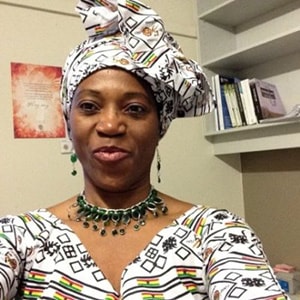
Photo provided by Veronica Fynn Bruey.
“Freedom,” Jean-Paul Satre once wrote, “is what we do with what is done to us.” Professor, lecturer, and award-winning scholar, Veronica Fynn Bruey, has faced some of the most challenging hardships one can imagine: poverty, war, displacement, racism, and violence. Through it all, she found the strength—through her mother, her own personal motivation, her community, and her work, to not only achieve success for herself, but also to help others—specifically victims of human trafficking—find the freedom and protection they deserve.
An Early Life of War and Displacement
Veronica Fynn Bruey was born in Liberia. When she was just 14, the civil war broke out there, and her family became displaced in their own country, and subject to violence and uncertainty. In July 1992, the family decided to flee to Ghana for safety.
“So yeah, that’s how we made it to Ghana. And on a deck of the Ghanaian peacekeeping vessel, three days, in the sunshine and in the rain. No food, no water until we arrived,” she explains.
While in Ghana, the family stayed in a refugee camp. However, things didn’t quite work out as planned, and in 1993, Fynn Bruey’s mother, who was sick, decided to bring the family back to Liberia, despite the ongoing conflict there. But Fynn Bruey, in what she describes as a “life-changing decision,” stayed in Ghana to pursue her education, “because my mom always said: education was the equalizer. And if we needed to make that change and escape the chain of poverty that we constantly had in our family, then I must listen to her and stay back.”
Six Degrees of Affirmation
Veronica Fynn Bruey’s hunger for education turned out to be insatiable, and it led her on her life’s path to earn not one…not two…not three…not four…not even five, but SIX academic degrees.
“People are always fascinated by how I’ve been able to acquire six university degrees given the fact that I came from a war zone,” she says, “and I lost three years of my life that I wasn’t in school, and another two years working, doing my national service in Ghana.”
She’s certainly made up for lost time. Starting in Ghana, with dreams of becoming a medical doctor, Fynn Bruey pursued an undergrad in zoology and biochemistry. But when she wasn’t accepted into the highly competitive medical school there, she didn’t fret. “I wasn’t going to waste my time and be like, without medical school, I’m doomed.”
Instead, Fynn Bruey headed to Canada to continue her education as a refugee-sponsored student, where she earned a BA from the University of British Columbia. She chose to study psychology.
“I came to Canada with a lot of trauma of abuse, I mean, both physical and sexual abuse, from my childhood, and it had haunted me a lot. So, I didn’t do psychology to help anybody else—just myself!” Fynn Bruey explains.
Soon afterwards, Bruey decided to go to England to get her Master’s in Public Health. She liked the more holistic approach of working with populations, and saw it as a better fit for her than medicine. The focus of her dissertation was on refugee mental health. “Of course, you can see where all this is going,” she says with a laugh.
Throughout her life, Fynn Bruey’s studies have been inexorably intertwined with her lived experience as a displaced person and refugee survivor of abuse who grew up with a single mother. But it wasn’t until 2003, when she was introduced by a mentor to a groundbreaking new book at the time: The Natashas: Inside the Global Sex Trade by Victor Malarek, that she encountered the term ‘human trafficking.’ It struck a chord.
“And so, I read it, and I was like, ‘Oh, this is not very much different from my experience of violence. You know, it’s not necessarily… in my case, nobody bought me or took me by force, it was some sort of coercion.” The book, she says, had a profound effect. “So, I was like, this is it for me—I’m going to explore this area, I’m going to give my all into it, because this violence has to stop!”
Fynn Bruey got shortlisted by a Government of Canada program to go to Geneva in 2006. There, she researched health and human trafficking at the International Organization for Migration, and started hanging out at the office of the United Nations High Commissioner for Refugees, with hopes of using her own experience as a refugee to jump start a career working with displaced people and combating human trafficking.
“I was constantly told I needed a law degree to work there. And I just couldn’t understand! I have three university degrees, and the lived experience of being a refugee, is that not good enough? Yeah… I still needed a law degree.” So Fynn Bruey got her Master’s in Law at York University’s Osgoode Hall Law School, focusing her dissertation on the legal discrepancies between protecting refugees and internally displaced persons. Prior to her Master’s in Law, she served as a research analyst for the Government of British Columbia’s Office to Combat Trafficking in Persons.
While in the program, Fynn Bruey was encouraged to get her PhD in law as well. “My supervisor said to me, you know, you are not married, you don’t have children. This is a good opportunity to do a PhD!” Eventually, she ended up at the Australia National University (ANU). But when she started applying for teaching positions, she was told she needed yet another degree… a bachelor’s in law.
“Actually, I did it concurrently with the University of London and ANU. It nearly killed me,” she says, laughing. “But I’m somebody who you can never tell that something is impossible to do. Because I will prove to you, with this incessant and daring personality, that I can do it. Even if it costs my own death, I will do it!”
Connecting the Dots of a Clandestine Industry
Fynn Bruey’s wealth of knowledge that comes from studying over half a dozen fields around the globe deeply informs her work in human trafficking. It’s because, she says, these fields—feminism and reproductive rights, public health, migration and displacement, indigenous and race studies, systemic violence, and international law—are all linked.
A cross-disciplinary approach, Fynn Bruey says, addresses the need to see human trafficking as a complex issue. “You need to bring in the feminism aspect, you need to bring the racism aspect, you need to bring a public health aspect into it. You need to bring in patriarchy and power and control, economics and finance.”
For example, understanding psychology, systemic violence, and international law comes in handy when dealing with one aspect of human trafficking—coercion. The United Nations defines human trafficking as recruitment or harboring of people “by means of the threat or use of force or other forms of coercion.” When people are coerced, Fynn Bruey says, they “consent” because they have no other alternative. Another part of what makes human trafficking such a difficult issue to address is its clandestine nature.
“It operates in secret. People who are vulnerable to these situations will never see the light of day; they’re locked up somewhere. Nobody knows whether they exist, or what is happening to them.”
This lack of data makes it hard to actually convict and prosecute traffickers. According to the latest 2019 Trafficking in Persons report, globally the number of new legislation passed to address human trafficking has reduced over the years, and prosecutions and convictions remain startlingly low in proportion to the number of victims reported.
Fynn Bruey says she’d rather spend years developing lasting solutions to combat human trafficking, than to simply adopt a unilateral response to the issue, which is “to limit a holistic or comprehensive approach that could be more lasting, that would be durable, and more sustainable.”
To that end, Fynn Bruey and her husband have started a non-profit called Tuki-Tumarankeh, which is a Wolof expression meaning, “It is the traveler who faces the most difficulty.” The non-profit is dedicated to advancing the welfare of displaced people through research, advocacy, and information, and publishes the world’s only academic journal devoted to raising the profile of displaced persons, the Journal of Internal Displacement (JID).
“That’s How Much It Is Part of My Core”
Throughout her remarkable life, Fynn Bruey’s stayed close to her roots—as a Liberian, a child of war, and a refugee from a very humble beginning. Drawing on her own experiences of trauma and abuse, Bruey is now committed to making sure that vulnerable people—women and children especially—can stay safe and protected, because, she says, “that’s what honestly keeps me grounded. And keeps me remembering that I can never forget where I came from, so that I can continue with that spirit of giving back to society, giving back to community, because a lot of people sacrificed for me to be where I am today.”
Fynn Bruey’s comprehensive education is a powerful tool she’s developed for fighting human trafficking. That, and her steadfast determination and indefatigable spirit to keep working, no matter what.
“Nothing anybody can do or say would deter me from continuing this journey,” Fynn Bruey says. “Because that’s how much it is part of my core.”
Back to Top
Welcome New Members
Please welcome our newest Global Washington members. Take a moment to familiarize yourself with their work and consider opportunities for support and collaboration!
Einstein Rising
Einstein Rising empowers Africa’s social entrepreneurs through its SME business development curriculum and provides access to startup capital. These wealth creators develop for-profit companies that tackle entrenched social and environmental issues without sacrificing the financial bottom line. einsteinrising.org
FIUTS
The Foundation for International Understanding Through Students (FIUTS) advances international understanding through cross-cultural experiences, student leadership, and community connections. Founded at the University of Washington in 1948, FIUTS programs connect international students, U.S. students, children and K-12 schools, and members of the community through programs that inspire dialogue and cultural exchange. fiuts.org
Gorman Consulting
Gorman Consulting is a firm that provides specialized measurement and evaluation services, primarily in the health sector. gormanconsulting.org
Back to Top
Member Events
July 12: West African Vocational Schools // Banquet
August 1: Upaya // 2019 Breakfast Briefing
Back to Top
Career Center
Program Coordinator, Amplio
Associate, Community Engagement, UNICEF USA
DV Services Program Manager II, YWCA of Seattle-King-Snohomish County
Check out the GlobalWA Job Board for the latest openings.
Back to Top
PRESS RELEASE: Bloodworks Northwest Names New President and CEO
Curt Bailey Begins as President & CEO at Bloodworks June, 2019
PRESS RELEASE

Curt Bailey, MBA, newly announced president & CEO of Bloodworks Northwest
Seattle, WA – Bloodworks Northwest’s Board of Trustees has announced the appointment of Curt Bailey, MBA, as Bloodwork’s president and CEO, succeeding James P. AuBuchon, MD who served in the position for 11 years. Curt Bailey, a leading expert in healthcare transformation, began his duties June 3, 2019, following Dr. AuBuchon’s retirement May 3, 2019.
“We are fortunate to have found such a capable individual to build on the legacy of Dr. AuBuchon’s extraordinary leadership in providing Bloodworks with a sound foundation to now pivot into an innovative future of improved blood health, providing the best care to everyone in our community and preserving the 75-year legacy of the organization,” said Craig Smith, MD, Chair, Bloodworks Board of Trustees. “I’m confident Bailey’s exceptional knowledge of the healthcare industry, business breadth and creativity will guide Bloodworks forward to a bold future in the evolving healthcare market.”
Continue Reading
How to Scale Global Conservation

@lldmtt via Twenty20
Partnerships are key to driving large-scale investment in the world’s natural capital
by Seth Olson, Analyst, Innovation
In 2014, Credit Suisse released a groundbreaking report that called attention to the 250-350 billion dollar funding gap in the conservation of natural resources. Several entrepreneurs, impact investors, and donor organizations reframed this gap as an opportunity. They began driving capital toward conservation and regenerative enterprises in their communities and across the globe.
Five years later, the growth of the conservation finance industry has led to better data analysis—and more sophisticated models. Organizations are realizing that they can amplify their impact by working together, rather than trying to take deals from start to finish on their own. Moving forward, it is partnerships that will accelerate the conservation finance industry’s growth.
Read more at Resonance.
June 2019 Newsletter
Welcome to the June 2019 issue of the Global Washington newsletter.
IN THIS ISSUE
Letter from our Executive Director

A UN report in May raised alarm about an increasing rate of species going extinct globally, with nearly 1 million plant and animal species at risk. It may be tempting to give up in the face of such overwhelming numbers. But the leaders of two Global Washington member organizations, the Woodland Park Zoo and the Seattle Aquarium, reminded us in a recent Seattle Times op-ed that “…we are not too late to act.” In fact, now is the time to accelerate the progress we have already made, and to look for new opportunities for transformational change when it comes to conserving life below the water (SDG 14) and life on land (SDG 15).
Global Washington’s latest issue campaign examines how wildlife conservation intersects with human development. Last week, Global Washington supported an event organized by the World Affairs Council, focused on local organizations that are leading the world in efforts to combat illegal wildlife trafficking. In this month’s issue brief we explore the various strategies that our members and others are using to protect endangered animals and the natural resources that we all depend on. Our Goalmaker this month is Alejandro Grajal, President and CEO of Woodland Park Zoo, and our featured organization is Vulcan, whose data-driven solutions to conservation reflect founder Paul Allen’s commitment to technology as a force multiplier for change.
I hope you enjoy this month’s issue as a bit of summer reading. Not only are the animals adorable, but the fact that their fates and ours are so closely entwined means that in helping them, we are also helping ourselves.

Kristen Dailey
Executive Director
Back to Top
Issue Brief
How Can Wildlife Conservation Support Human Development?
By Joanne Lu

Photo provided by The Snow Leopard Trust.
Conservation and human development are often presented as two separate issues with little overlap: one promotes the wellbeing of our planet and other species, while the other cares for people. But a new UN assessment is warning that a million plant and animal species are at risk of extinction within decades – and it’s threatening human life, as well.
Regardless of whether we live in wealthy or poor countries, our fates as humans are inextricably tied to those of other species. Together, we inhabit ecosystems that supply us with basic services such as food, water and air. Just in the Americas alone, natural ecosystems provide humans an estimated $24 trillion worth of economic value every year, equivalent to the region’s entire gross domestic product.
But even though the earth is supplying people with more food, energy and materials than ever, the UN report says that the activity of more than 7 billion people is altering our natural world at a rate that is “unprecedented in human history.” Increasingly, our farming, fishing, poaching, logging and mining are undermining nature’s ability to continue to provide those very things for us in the future, in addition to other services like water quality regulation.
At the same time, global warming caused by our activities is further driving some wildlife toward extinction. Already the world is 1 degree Celsius warmer than pre-industrial levels. If that increases to 2 degrees, the report estimates that about 5 percent of species globally are at risk of climate-related extinction. If temperatures continue to rise to 4.3 degrees above pre-industrial levels, the existence of 16 percent of species will be threatened.
As cohabitants of our environment, it is our human responsibility to respect and protect wildlife. But we also need them to thrive in order for us to thrive. We depend on them as food supplies, pest control, pollinators, medicine, genetic resources and centers of tourism. Our fates are so entwined with wildlife and their habitats that the UN report estimates that the current negative trends will “undermine progress towards 80 percent” of the Sustainable Development Goals relating to poverty, hunger, health, water, cities, climate, oceans and land.
“Our wildlife is not an optional extra, but the basis upon which all our livelihoods and progress depend,” the late Bradnee Chambers, Executive Secretary of the Convention on Migratory Species, said in 2017. “Only by integrating wildlife conservation with sustainable development will we be able to protect the remaining species on Earth, species from which we benefit in so many different ways.”
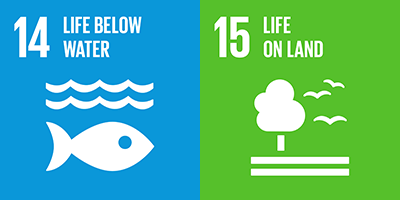
That’s why organizations like Vulcan support work in Zambia to protect wildlife from poaching, trafficking, and loss of habitat, as well as to prevent human-animal conflicts. As the human population around South Luangwa National Park increases with development of the area, so, too, there’s been an increase in community conflicts with elephants that are raiding crops and damaging properties. By engaging with the local communities, Vulcan and its partners are finding ways to mitigate these conflicts in ways that protect both the elephants and the farmers. Interventions include elephant restraining fences, chili peppers as a deterrence, watch towers and elephant-safe grain stores. In addition, Vulcan used its technology to help compile the Great Elephant Census, the first aerial survey in 40 years of African savanna elephants across the continent.
Similarly, the Snow Leopard Trust works closely with local communities to protect the endangered and elusive snow leopard and its mountain habitat. Established in 1981 by a staff member of Woodland Park Zoo, the Trust was one of the first conservation organizations to make the economic and social needs of communities in the snow leopard’s habitat part of their conservation solution.
The Snow Leopard Enterprises program, for example, creates economic opportunities (handicraft businesses) for herder women in snow leopard habitats. This financial boost makes families more economically resilient to the occasional loss of livestock to snow leopards. In turn, herders are less inclined to retaliate against the snow leopards. Additional cash bonuses are also awarded to communities if they uphold their conservation commitments.
Woodland Park Zoo continues to partner with the Snow Leopard Trust and supports its conservation programs in Kyrgyzstan. The Zoo carries out other conservation work, as well. Its flagship program works to protect tree kangaroos in Papua New Guinea (PNG) using a community-based strategy similar to what the Snow Leopard Trust employs. In 2009, the Zoo celebrated the PNG government’s approval of a tree-kangaroo habitat as a conservation area with the highest level of protection, including against any form of resource extraction. Since then, the program has been empowering indigenous communities to take on the long-term, sustainable management of the area.

Ecki, a young Matschie’s Tree Kangaroo born at Woodland Park Zoo. The zoo’s Tree Kangaroo Conservation Program preserves tree kangaroos’ natural habitat in Papua New Guinea’s Huon Peninsula and supports livelihoods of the indigenous people there. (Photo: Jeremy Dwyer-Lindgren/Woodland Park Zoo).
This vision of human development alongside conservation has birthed some unlikely partnerships. Recently Americares, an organization best known for its donations of medicine and medical supplies, launched a partnership with African Parks to provide comprehensive health care for the communities that live in and around conservation areas. African Parks manages 15 wildlife parks in nine countries, but the partnership will begin by serving nearly 100,000 people near two of Malawi’s most important conservation areas.
Conservation efforts are also required thousands of miles away from the habitats of endangered and threatened species. Organizations like Fair Trade USA and Earthworm (formerly The Forest Trust) work with companies to ensure that their sourcing and production don’t harm wildlife habitats. Among its other efforts to promote environmental sustainability, Fair Trade USA partners with Conservation Alliance for Seafood Solutions, which provides businesses expertise and tools for furthering their commitments to sustainable seafood.
Earthworm uses tools like High Conservation Value (HCV) and High Carbon Stock (HCS) forest assessments to help guide activities away from important wildlife areas. It also carries out work on the ground to help mitigate human-animal conflicts in Malaysia, for example, or to teach palm oil plantation companies how to protect orangutan habitats.
These organizations are all taking important steps toward protecting the biodiversity of our planet. Still, the UN assessment warns that the Sustainable Development Goals for 2030 may only be achieved through widespread “transformative changes” in the ways we produce and consume everything from energy to food to water to materials.
That’s why organizations like the Seattle Aquarium and Woodland Park Zoo are so committed to inspiring conservation at home. By providing visceral experiences, education, and tools for the public to participate in conservation, as well as their own commitment to conservation principles, these organizations aim to transform how the broader Seattle community views and interacts with life all around us. Changing that perspective is the first step to making conscious choices that move us toward sustainable development – not only for humans, but for our whole world.
* * *
The following Global Washington members are working at the intersection of conservation and human development.
Americares
Americares understands that the health of humans and the health of the natural environment are inextricably linked. In May 2019, Americares announced it would be teaming up with wildlife conservation organization, African Parks, to strengthen the capacity of local health centers providing care to people living in and around Africa’s protected areas. The partnership launched in Malawi, where Americares and African Parks will improve access to health care at four health centers, serving nearly 100,000 people near two of Malawi’s most important conservation areas—Liwonde National Park and the Majete Wildlife Reserve—both of which are managed by African Parks on behalf of the Malawian Government. The new partnership will allow the organization to carry out its mission with vulnerable populations living in close proximity to wildlife while advancing conservation efforts that protect ecosystems and benefit communities. americares.org
Earthworm
Earthworm is a global non-profit organization that works with companies and other stakeholders to make value chains an engine of prosperity for communities and ecosystems. Active in key commodity producing regions around the world, Earthworm helps companies to ensure that their sourcing and production does not impact wildlife habitat, including that of endangered and threatened species. Tools such as High Conservation Value (HCV) and High Carbon Stock (HCS) forest assessments help guide development activities away from areas that are important for wildlife. In several regions, Earthworm works directly on specific wildlife management challenges. For example, in East Kalimantan, Indonesia, Earthworm staff have trained palm oil plantation companies and others on how to better protect orangutan habitat. In Sabah, Malaysia, Earthworm is working with farmers, plantations, and government authorities to find solutions for mitigating human-elephant conflict in areas where elephants roam beyond the boundaries of protected areas. earthworm.org
Fair Trade USA
Fair Trade USA is a non-profit organization that promotes sustainable livelihoods for farmers and workers, protects fragile ecosystems, and builds strong, transparent supply chains through independent, third-party certification. Its trusted Fair Trade Certified™ seal signifies that rigorous standards have been met in the production, trade and promotion of Fair Trade products from over 50 countries across the globe. FairTrade partners with Conservation Alliance for Seafood Solutions, a leading conservation group, with the goal of improving ocean health and ensuring a long-term supply of seafood. fairtradecertified.org
Global Family Travels
In partnership with non-profit organizations and schools, Global Family Travels provides sustainable travel itineraries that foster cross-cultural understanding and align with the UN Sustainable Development Goals, including SDG 15: Life on Land, SDG 6: Clean Water and Sanitation, and SDG 4: Quality Education. For example, families might elect to travel to Zimbabwe in support of conservation of the African Painted Dog. globalfamilytravels.com
The Snow Leopard Trust
The Snow Leopard Trust aims to better understand the endangered snow leopard, and to protect the cat in partnership with the communities that share its habitat. The organization has programs and staff in the five countries in Central Asia that together contain over 75% of the world’s population of wild snow leopards. With support from around the world, the Snow Leopard Trust encourages and empowers people who live in the cat’s habitat to help protect their local wildlife and ecosystems. snowleopard.org
Resonance
Resonance is a global development consultancy that harnesses the power of collaboration to enable communities, companies and governments to drive market-based solutions to global challenges, including in natural resources conservation. In East Africa, Resonance worked with conservation stakeholders on two key partnerships: One was designed to reduce illegal wildlife poaching and trafficking through a reporting and enforcement technology platform; the other helped tourist lodges and hotels source food and services locally. Additionally, Resonance worked in SE Asia to mobilize private-sector resources and investment to strengthen sustainable fishing practices and diversify economies in coastal communities. In the Philippines, Resonance developed a national enforcement partnership between a telco, Microsoft, maritime law enforcement, and fishing communities to reduce illegal fishing, resulting in 10,000 reports, and a seizure of more than 4,000 pieces of contraband. resonanceglobal.com
Seattle Aquarium
The Seattle Aquarium is a respected authority on the Salish Sea, Washington Coast and greater Pacific Ocean, and serves as the largest platform for ocean conservation and engagement in the Pacific Northwest. Through emerging partnerships and community programming the Aquarium is fostering an emerging ocean ethic, increasing awareness and taking action to help preserve and protect our marine environment. The Aquarium offers a unique window into ocean conservation by offering: compelling exhibits and event experiences; education programs for people of all ages and backgrounds; community outreach to underserved communities; conservation research that advances understanding and improves management of marine species; advocacy and policy work; an award-winning volunteer program; and more. Guided by our mission of Inspiring Conservation of Our Marine Environment, the Aquarium has reached over 27 million visitors, two million school children and is taking on the awesome responsibility of protecting our one world ocean and the amazing creatures that call it home. seattleaquarium.org
Vulcan
Vulcan Inc. pursues initiatives and projects that seek to change the trajectory of some of the world’s most difficult challenges. Vulcan works to improve our planet and support our communities through catalytic technology, philanthropy, scientific research, story-telling and commercial ventures. Founded by technologist and philanthropist Paul G. Allen, Vulcan continues to develop and grow the ideas about which he was passionate. vulcan.com
Woodland Park Zoo
Woodland Park Zoo saves species and works to inspire everyone to make conservation a priority in their lives. The Zoo supports conservation programs in over 30 landscapes around the world, with a strategy aimed at habitat and species conservation, research, education, local capacity building and community management. This includes multiple conservation projects here in the Pacific Northwest, from monitoring wolverine recovery in the Cascades to bringing back the northwestern pond turtle from near extinction. Internationally, Woodland Park Zoo’s Tree Kangaroo Conservation Program has worked with indigenous communities in Papua New Guinea since 1996 to protect the endangered tree kangaroo and its rain forest habitat. In 2009, the Zoo partnered with 50 communities to create the country’s first-ever community managed Conservation Area. The program is successfully working with community members on scientific research, land-use mapping, education, health, and directly improving livelihoods through the international sale of conservation YUS coffee, which can be purchased right here in Seattle. zoo.org
Back to Top
Organization Profile
Informing Change: Vulcan’s Data-Driven Approach to Conservation
By Amber Cortes
Empowered by Paul Allen’s vision to make a positive difference in the world, Vulcan shares a commitment to improving our planet. As Vulcan looks to tackle some of the world’s hardest problems, it asks, “What solution should exist that doesn’t?” This question has led Vulcan to develop and deploy a range of solutions to help with the protection and conservation of wildlife, ocean health, and their ecosystems, including EarthRanger, Allen Coral Atlas, Skylight, and the Great Elephant Census.
Based on his time at Microsoft, Allen had the power to change things on a global scale, and as a billionaire, his philanthropic impact could be felt on a scale far and wide.
But Allen was a pragmatist at heart, so he wanted to be realistic. That meant he had to focus on not just any kind of global problems, but certain kinds of problems—ones that have an ‘accelerating curve’ of urgency to them, and come with only a limited window of time to figure out solutions.
“In other words, what that means is that the longer we wait to try to solve those problems, the harder it becomes to solve them,” says James Deutsch, director of biodiversity and strategy at Vulcan. “And that’s obviously true about climate change. But it’s also true, for example, about biodiversity loss or disintegration of natural marine ecosystems.”
A recent UN assessment said that due to human-induced changes to the natural environment, around 1 million species already face extinction, and that “…there will be a further acceleration in the global rate of species extinction, which is already at least tens to hundreds of times higher than it has averaged over the past 10 million years”—unless action is taken.
As an avid scuba diver and lover of nature, Allen saw the destruction of wildlife and marine ecosystems for himself—like the mass coral bleaching that caused half the Great Barrier Reef to die. He also recognized that the economic consequences tied to the loss of coral reefs could cost up to $1 trillion globally, and decimate local economies.
Allen, who, together with Bill Gates, helped revolutionize the world with Microsoft, knew better than anyone that tech and data-based solutions could help solve complex global problems in ways that struggles for policy change alone could not reach.
For example, Vulcan initiated the Great Elephant Census after China and Japan
started loosening some of their restrictions on the sale of ivory. Elephant poaching in Africa accelerated in response to the new demand—and by 2013, conservationists on the ground in Africa knew there was a poaching crisis. But anecdotal evidence was not enough to convince the international community that there was a problem.
The Great Elephant Census was the first ever effort to count all of the elephants in the African Savannah—spanning three years, costing about $7 million, and involving 20 governments and multiple NGO partners to carry out the surveys.
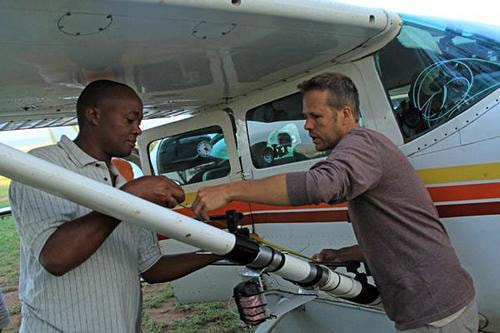
The census proved there had been an alarming decline in elephant populations, directly linked to poaching. And according to Deutsch, the real power of the data was that it was quantitative, not anecdotal, so it forced people to look at the truth—and take action.
“It provided crystal clear results that over the previous seven years, the population of elephants had declined by 30%. And people couldn’t hide from that data,” says Deutsch.
The results of the census reinforced the work of many partners, from the U.S. government to conservation NGOs, to persuade the International Union for Conservation of Nature (IUCN) and the Convention on International Trade in Endangered Species (CITES) to agree that all nations should close their ivory markets. In 2016 China announced a shutdown of all ivory trade within its borders.
The ripple effect of The Great Elephant Census worked locally, too, resulting in significantly increased government clampdowns on illegal wildlife destruction in Tanzania and Mozambique (two countries shown to be at the ‘epicenter of poaching’), and renewed conservation efforts in places like West Africa’s W-Complex of parks, where elephant populations were doing surprisingly well.
One important role data technology can take on in the fight against wildlife loss is centralizing information for a quick, organized response. For example, national parks in Africa were not getting real-time information to ranger patrols. So Vulcan developed EarthRanger—a comprehensive software program for tracking wildlife, rangers, vehicles, and poaching incidents and integrating that information for park managers on a single big screen to optimize their deployment of rangers and decision-making.
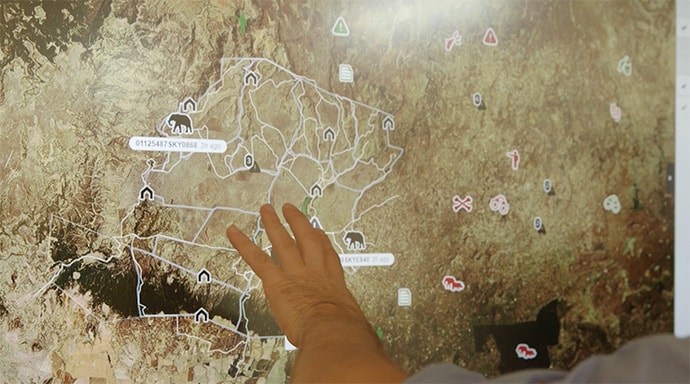
EarthRanger is now active in 14 parks in Africa (with plans for global expansion). But its success only happened because researchers spent time in the field asking people who were trying to protect wildlife in parks what tools they needed to do their job better. In fact, Vulcan spends a significant portion of time and energy on the R&D phase for its philanthropic projects—which is just what any tech company would do to guarantee the best user experience for its product.
For example, The Allen Coral Atlas is the first global mosaic map of the world’s coral reefs, developed because there was no one map of coral reef damage across the world—just a handful of institutions, communities, and researchers who were mapping and monitoring their own reefs on a local level, which was expensive and often cumbersome. With the advancement of satellite technology, Allen saw potential.
The Allen Coral Atlas is meant to be an all-purpose tool for researchers, divers, universities, governments, and scientists alike. That means that, in terms of user experience, there are lots of different uses—and potential users.

“It’s a really interesting hybrid process that includes a good deal of traditional philanthropy and science, but then really intensive user research and interviews to figure out what the people doing the work in their communities, like coral reef restoration, need,” explains Deutsch.
Similarly, Allen recognized that the new higher resolution satellites being launched into space could provide better data for combatting another global biodiversity challenge—the theft of fish by illegal international trawlers from some of the poorest countries in the world. That led to Skylight, launched in 2017, a real-time, AI-powered system for alerting developing countries and their NGO partners of illegal fishing activity in their territorial waters and protected areas.
Vulcan’s technology and data projects take advantage of the tremendous pool of talent in Seattle and partnerships with the tech sector. But it’s not just issues abroad that get Vulcan’s attention. On the local front, Vulcan has donated millions to support statewide conservation efforts. For instance, Vulcan helped get I 1401, an anti-trafficking statewide ballot measure, passed in Washington state in 2015.
“And that was a really interesting case in which I think Paul and Vulcan felt that there was a moral imperative to get our own house in order on this international issue. And not to be part of the problem ourselves as a community,” says Deutsch.
Deutsch adds that Vulcan’s local conservation efforts can serve as a model of leadership—and not just in the philanthropic realm, but across other business sectors, as well. Vulcan Real Estate, for example, was the world’s first salmon-safe accredited developer.
Climate change and the unprecedented decimation of wildlife and natural systems by human activity are daunting, huge problems that seem impossible to stop. But for someone who works on giant global issues like the environment and public health, Deutsch sees hope in small successes, pointing to the growth of green energy and the electrification of transport systems as paradigm-changers.
“The question then is,” he asks, “is it possible that those specific successes could radiate out into a more general success, that we could leave a world to our kids and grandkids in 2050, and beyond? A world that is still functional, life supporting, rich, beautiful, and a nice place to live? And I guess part of the answer is that each of those small successes has to start to knit together into a global change.”
For Vulcan, it’s clear from the data that for each small success, the numbers can really add up.
Back to Top
Goalmaker
Alejandro Grajal, President and CEO of Woodland Park Zoo
By: Arielle Dreher
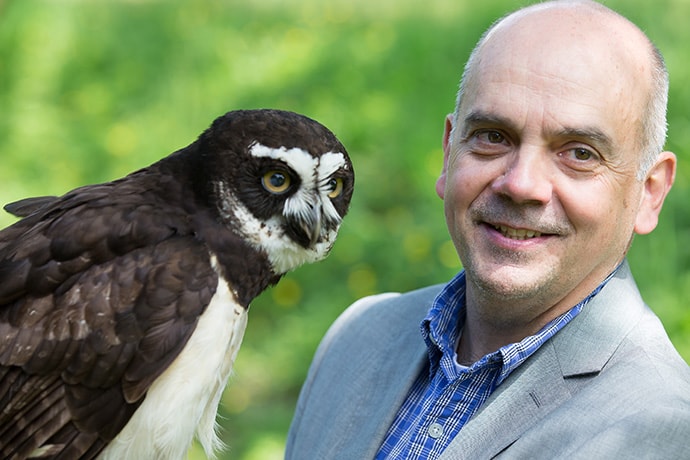
While politicians and celebrities alike routinely rally communities to save the planet, other not-as-obvious, yet incredibly influential forces are already at work: zoos.
Alejandro Grajal knows a thing or two about how zoos can play a role in large-scale conservation efforts. He was in graduate school, finishing a PhD in zoology from the University of Florida, during the conservation biology movement of the 1980s, and he has been invested in its progress and impacts ever since. Grajal, the current CEO and President of the Woodland Park Zoo, believes that conservation efforts ultimately start and end with humans.
“One of the things that has been pretty evident to me from the very beginning is that even though conservation or wildlife conservation is a biological problem, the causes and the solutions are human because extinction and habitat loss and so on are created by humans, but also can be solved by humans,” he said.
Conservation has been at the heart of Grajal’s studies and his professional career. He came to the Woodland Park Zoo in 2016 after beginning his professional life at the Wildlife Conservation Society in New York (which runs the Bronx Zoo) and then leading the Center for Conservation Leadership at the Chicago Zoological Society. He has specialized primarily in field conservation, meaning protecting large areas of habitat and land, primarily in Latin America and the Caribbean. He has also published numerous articles and conducted research on conservation for most of his career.
Zoos play a vital role in conservation efforts globally. Grajal’s work not only at the Woodland Park Zoo but also as a board member for the Association of Zoos and Aquariums (AZA), which accredits all zoos and aquariums in North America and abroad, is conservation-focused. In fact, Grajal says they are the second largest source of funding to international conservation efforts worldwide. According to the AZA, the 230 zoos and aquariums in the association have donated over $1 billion in funds to field conservation in the past five years.
About 8 percent of the zoo’s annual budget is spent on international conservation, Grajal said. The Woodland Park Zoo has nearly 20 conservation flagship projects that involve multi-decade investments in field conservation in places as far away as Papua New Guinea and as close as the North Cascades.
In addition to investment, which Grajal says is the most significant way zoos play a role in conservation, they also literally play a role in conserving species. Endangered species, or animals that are in danger of going extinct, are often preserved as a result of zoos and aquariums taking in those animals. Grajal explained that this process is vital to the species’ survival. For example, the Woodland Park Zoo currently has three Malayan tigers. There are only about 200 of these tigers left on earth, and the majority of those left are in zoos. With less than 100 wild Malayan tigers, the ones living in zoos might be the last surviving animals of their kind in a few years.
“The population in zoos and aquariums right now is radically valuable to keep the genetic makeup of the population for the future, because the population in the wild is not thriving,” Grajal said.
The Woodland Park Zoo is AZA-accredited, meaning it could also hold or keep species protected in the association’s program SAFE (Saving Animals From Extinction). SAFE is a global strategy to ensure that endangered species are protected, Grajal said. There are currently 30 SAFE action plans for species, with more in the works.
Conservation efforts taken by outside organizations and even zoos in the U.S. are, in the end, only drops in the bucket, and Grajal recognizes this. And yet, sociological and psychological research conducted at the Woodland Park Zoo to evaluate the visitor experience has led to interesting findings.
“We know for sure that one of the critical elements of the zoo visit is that people have this flow of positive emotions,” Grajal said.
This is in part due to the connections with animals, as well as visiting with loved ones, Grajal said.
“The combination of really strong social brainwork for the visit and the emotions that are driven by the zoo really drive an unusual combination of willingness to act,” Grajal said.
The question is how to turn that positive emotion into action. Or as Grajal says, “How do we get those emotions supercharged so we can drive people towards pro-environmental behaviors?”
While the science and research at Woodland Park Zoo shows the zoo visit can lead to a powerful emotive experience, visiting the zoo only lasts four to five hours at most. To keep that positive emotive experience, Grajal said, the zoo’s social media investment aims to create more opportunities for people to engage in conservation.
The organization currently has 54,500 followers on Instagram and more than 32 million views on its Youtube channel. In addition, its website address is literally zoo.org, which doesn’t hurt the organization’s online search rankings.
Ultimately, Grajal said all this content points to what needs to happen to actually conserve the planet and our shared environment: consumers changing their behaviors.
“We try to keep the fun and family and hopeful message of coming to the zoo, while at the same time creating opportunities for people to engage in conservation, mostly by taking specific consumer positions such as composting, recycling or buying sustainable seafood products, or eliminating single-use plastics from your life,” Grajal said.
The zoo can leverage its substantial social media following when the environment is threatened by policy proposals, as well. For example, The Woodland Park Zoo sent more than 10,000 signatures as a part of a petition to Congress when the Trump Administration attempted to change the Endangered Species Act. Grajal expects to grow the zoo’s role as part of a larger social movement towards conservation.
“I believe that one of the challenges we face in terms of conservation is the support of the public, regardless of their political ideology or their socioeconomic status. It’s been for a while that conservation has kind of morphed into or been pigeon-holed into this kind of white, middle class values ideal, but the reality is that conservation and the conservation of wildlife affects everybody, rich and poor, different cultures, different languages,” he said.
By engaging zoo visitors and contributing to a wider social movement towards conservation, the zoo also plans to continue to measure its impact and see if social responsibility grows. Ultimately, the health and survival of all is at stake.
“It’s really important that people understand that their actions and everyday decisions have global implications,” Grajal said. “And all those things (like eliminating single-use plastic) look very flimsy, very small when you do them by yourself, but the reality is that if you get millions joining it, you have a significant impact. You drive corporations and businesses to make responsible decisions, and then we have positive feedback in which both consumers and providers and policy all move in the right direction.”
Back to Top
Welcome New Members
Please welcome our newest Global Washington members. Take a moment to familiarize yourself with their work and consider opportunities for support and collaboration!
Philanthropy Northwest
Philanthropy Northwest is the network for philanthropists of all types who are committed to Alaska, Idaho, Montana, Oregon, Washington and Wyoming. We promote, facilitate and drive collaborative action by community investors to build resilient, equitable and inclusive communities. philanthropynw.org
PwC
PwC helps resolve complex issues and identifies opportunities. PwC bring a global perspective along with in-depth knowledge of local, state and US issues, and focus on audit and assurance, tax and consulting services. Additionally, in the US, PwC concentrates on 16 key industries and provides targeted services that include — but are not limited to — human resources, deals, forensics, and consulting services. PwC’s reputation lies in building lasting relationships with clients and focusing on delivering value in all they do. pwc.com
Back to Top
Member Events
June 20: International Rescue Committee // ARTvocacy 2019: World Refugee Day Celebration
June 25: Woodland Park Zoo // Women in Conservation: Saving Local Species at Woodland Park Zoo
Back to Top
Career Center
Staff Accountant, Bloodworks Northwest
Grants Specialist, International Rescue Committee
Fall, Spring Law Student Internships, Northwest Immigrant Rights Project
Associate, Community Engagement, UNICEF USA
Manager, Finance & Accounting, Vulcan Inc.
Check out the GlobalWA Job Board for the latest openings.
Back to Top
GlobalWA Events
June 20: Final Mile Disaster Response: Amazon’s Community Engagement
Back to Top
New Fall 2019 Cohorts Forming
Gain practical strategies to advance your organization. Learn alongside a trusted community of leaders of global NGOs and nonprofits, foundations and related organizations, who are dedicated to their work and to each other.
Information and Orientation Sessions
Tuesday, June 18, 9:00 – 10:00am
Wednesday, June 26, 1:00 – 2:00pm
To attend an info session or learn more email rakow.bernier@gmail.com or call 206-250-6383.
Back to Top
EVENT RECAP: Illegal Wildlife Trafficking: Local Efforts on a Global Threat
By Andie Long, GlobalWA
On Thursday, June 11, 2019, the World Affairs Council of Seattle hosted an event to highlight the alarming increase in wildlife poaching and trafficking of illegal animal products globally. With spokespersons from University of Washington, Vulcan, Woodland Park Zoo and the Port of Seattle, the event gave a sense of the scale of the challenge, as well as what local organizations are doing to address it.
As a community partner to WAC Seattle, Global Washington supported the event and distributed copies of a new issue brief with specifics about organizations that have ties to Washington state and are working at the intersection of wildlife conservation and human development.
The event opened with a lively presentation by Washington Department of Fish & Wildlife Detective Lauren Wendt, together with her partner, a Labrador retriever named Benny, who helps track down smugglers of illegal wildlife products. Together Detective Wendt and K9 Officer Benny patrol the state’s ports of entry to shut down illegal trafficking operations.
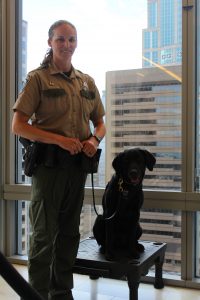
Washington Department of Fish & Wildlife Detective Lauren Wendt with her K9 partner, Benny.
Continue Reading
Opinion: We have only one planet, and it is speaking to us
SEATTLE TIMES
May 15, 2019
By Alejandro Grajal and Robert W. Davidson
Special to The Times
Everyone deserves the opportunity to share in the wonder of nature, but the fact is that many species around the world need our help. The United Nations last week released urgent and sobering findings from a three-year research project forecasting the extinction of nearly 1 million animal and plant species due to climate change and human impacts to the environment.
In the report, 450 scientists sounded the alarm and clearly described the impending extinction crisis. It is hard not to feel overwhelmed and even paralyzed by what seems to be a global disaster that none of us can avert. As leaders of two of the region’s best-known cultural institutions focused on conserving the environment — Seattle Aquarium and Woodland Park Zoo — we feel it is vitally important, at what feels like an especially dark moment in time, to stress that we are not too late to act.
Read More











